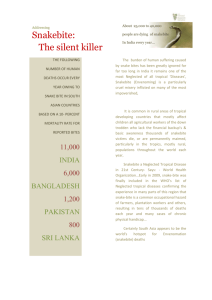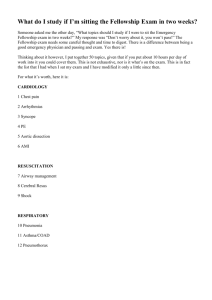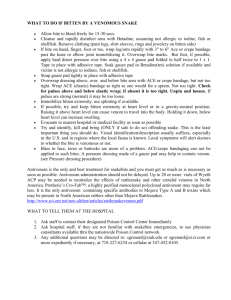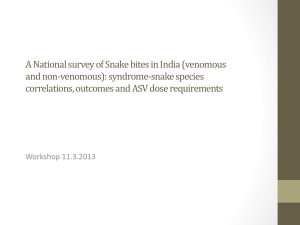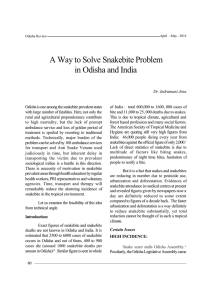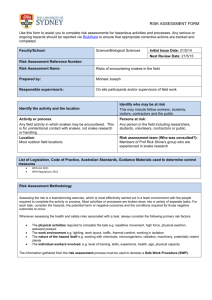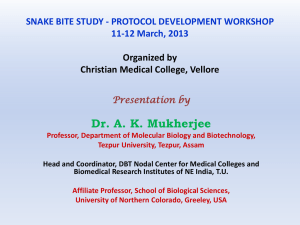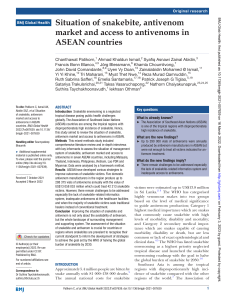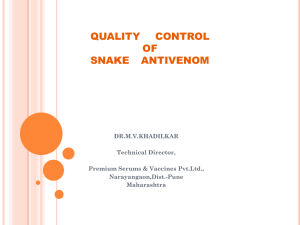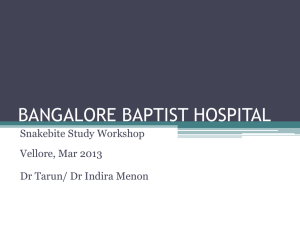Snakebite: how a public health emergency slithered
advertisement
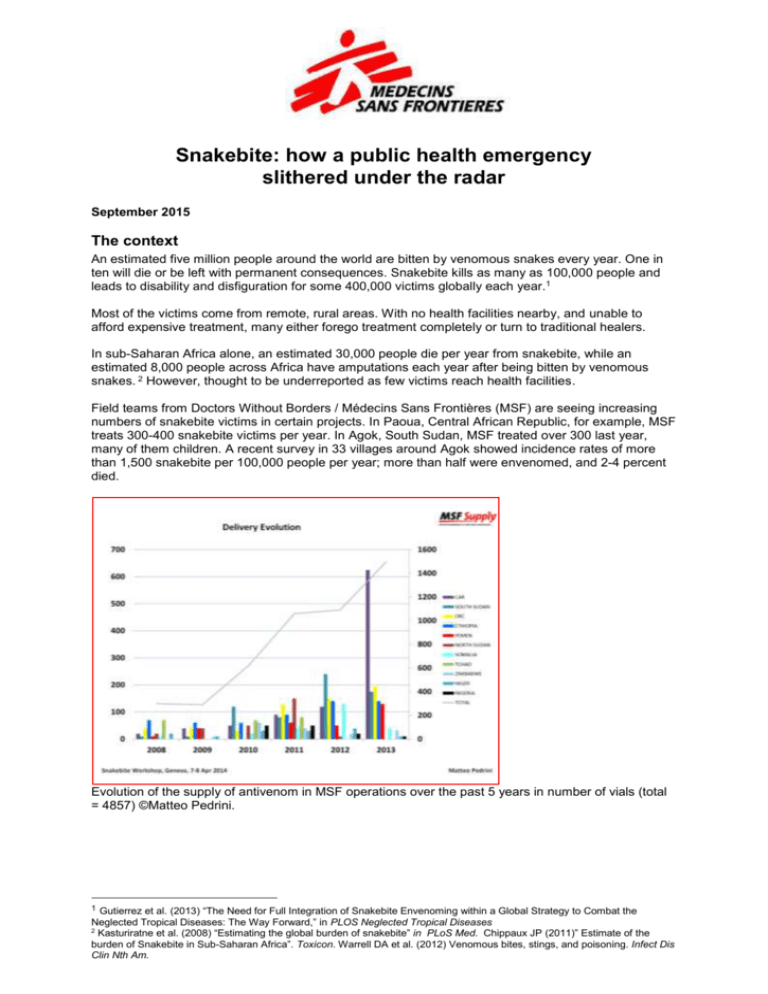
Snakebite: how a public health emergency slithered under the radar September 2015 The context An estimated five million people around the world are bitten by venomous snakes every year. One in ten will die or be left with permanent consequences. Snakebite kills as many as 100,000 people and leads to disability and disfiguration for some 400,000 victims globally each year.1 Most of the victims come from remote, rural areas. With no health facilities nearby, and unable to afford expensive treatment, many either forego treatment completely or turn to traditional healers. In sub-Saharan Africa alone, an estimated 30,000 people die per year from snakebite, while an estimated 8,000 people across Africa have amputations each year after being bitten by venomous snakes. 2 However, thought to be underreported as few victims reach health facilities. Field teams from Doctors Without Borders / Médecins Sans Frontières (MSF) are seeing increasing numbers of snakebite victims in certain projects. In Paoua, Central African Republic, for example, MSF treats 300-400 snakebite victims per year. In Agok, South Sudan, MSF treated over 300 last year, many of them children. A recent survey in 33 villages around Agok showed incidence rates of more than 1,500 snakebite per 100,000 people per year; more than half were envenomed, and 2-4 percent died. Evolution of the supply of antivenom in MSF operations over the past 5 years in number of vials (total = 4857) ©Matteo Pedrini. 1 Gutierrez et al. (2013) “The Need for Full Integration of Snakebite Envenoming within a Global Strategy to Combat the Neglected Tropical Diseases: The Way Forward,” in PLOS Neglected Tropical Diseases 2 Kasturiratne et al. (2008) “Estimating the global burden of snakebite” in PLoS Med. Chippaux JP (2011)” Estimate of the burden of Snakebite in Sub-Saharan Africa”. Toxicon. Warrell DA et al. (2012) Venomous bites, stings, and poisoning. Infect Dis Clin Nth Am. Neglected emergency Snakebite is a major killer, yet remains one of the world’s most neglected public health emergencies, low on national and international health agendas. There are various reasons for this: it is hard to quantify exact numbers of victims; antivenoms – the lifesaving antidotes to snakebite – are expensive and only produced in limited quantities; research and development into diagnosing and treating snakebite is inadequate; and governments and donors have little interest in tackling the problem. At the same time, the World Health Organization (WHO) is failing to actively address the issue, and is still considering snakebite as a “neglected condition for which WHO has no formal programme”.3 The issue is also neglected within many of the worst affected countries, with governments and ministries of health failing to train health staff in properly diagnosing and managing cases of snakebite poisoning. The combination of these factors result in a serious lack of access to treatment for people in need. Snakebite envenoming is curable – when the right type of antivenom is available. However, treatments that are quality-assured and that have been proven safe and effective to use are rare. Those that do exist are often priced out of reach for those who need them. In sub-Saharan Africa, antivenom treatment can cost up to US$250-500 per victim. Although snakebite treatment using adapted antivenoms has been shown to be very cost-effective, there are currently no major donors funding the cost of treatment.4 This may be due to the fact that donors and global health agencies are not aware of the scale of deaths and injuries caused by snakebites. Across Africa, there is an urgent need for a single antivenom that is active against the venoms of multiple species of snakes. Meanwhile, the safety and effectiveness must be tested of some products already available on the African market without having been subjected to controlled clinical trials. FavAfrique, produced by French pharmaceutical company Sanofi, is one of the few products able to neutralise the venom of ten snakes across sub-Saharan Africa, and which has proven effective in saving lives. Sanofi stopped the production of Fav-Afrique in 2014, and the last batch of this product will expire in June 2016. While Sanofi is currently negotiating for another company to produce Fav-Afrique (a process known as ‘technology transfer’), negotiations are not expected to be finalised before late2016, which means that a replacement product could not be expected to reach the market for another two years. The absence of a safe and effective antivenom that is active against multiple toxins from June 2016 until at least the end of 2018 will translate into countless deaths. Snakebite envenoming is an issue that has been neglected for far too long. Global health agencies, donors, governments and pharmaceutical companies need to share responsibility for putting it where it belongs on the global health agenda, and taking immediate and collaborative action to address this major public health emergency. Recommendations WHO should play a leading role in tackling snakebite as a public health issue and should take immediate action to appoint a specialist to provide advice and guidance where needed. Governments and ministries of health should take responsibility for raising awareness in affected communities, and providing proper training for health staff in diagnosing and managing cases of poisonous snakebite. Serious gaps exist in our understanding of snakebite epidemiology and optimal treatment in sub-Saharan Africa. Further epidemiological studies on snakebite should be undertaken so as to develop suitable training, diagnostic tools and effective antivenoms. 3 http://www.who.int/neglected_diseases/diseases/en/ 4 Habib AG et al. (2015) “Cost-effectiveness of antivenoms for snakebite envenoming in Nigeria” in PLos Negl Trop Dis. International donors and funders of programmes to combat Neglected Tropical Diseases should fund the production of effective antivenoms for use in developing countries, and should fund R&D to improve antivenom development and production. Until alternative treatments are found, Sanofi needs to ensure the interim production of the Fav-Afrique antivenom. While the company's antiserum refinement unit is now focusing on producing another neglected product, rabies serum, Sanofi should at least generate the horse plasma needed to produce Fav-Afrique, and then find suitable opportunities to refine the plasma into antivenom.
